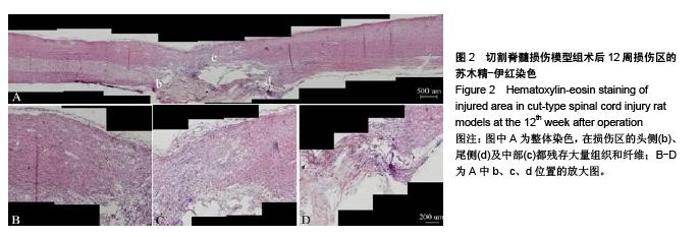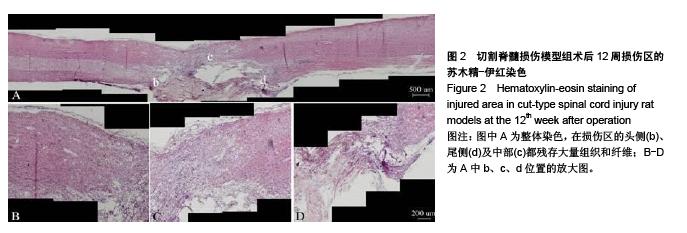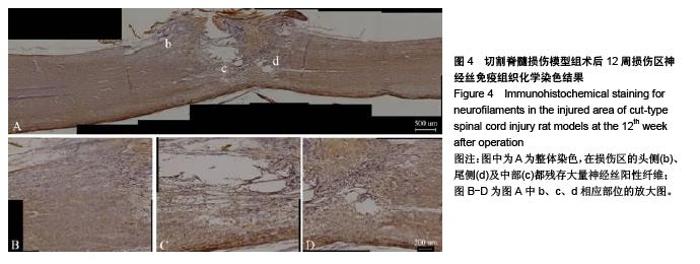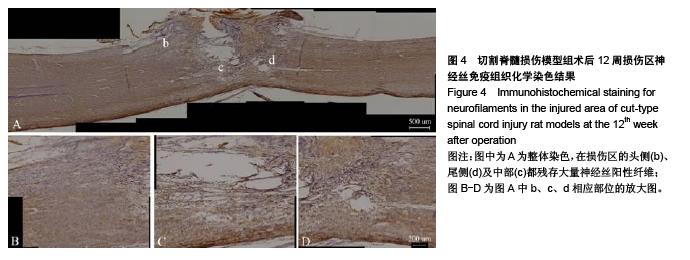Chinese Journal of Tissue Engineering Research ›› 2015, Vol. 19 ›› Issue (49): 7920-7925.doi: 10.3969/j.issn.2095-4344.2015.49.009
Previous Articles Next Articles
Behavioral and morphological changes of different spinal cord injury rat models
Song Wei1, 2, Duan Hong-mei3, Rao Jia-sheng3, Zhao Can3, Yang Zhao-yang4
- 1Capital Medical University of Rehabilitation Medicine, Beijing 100068, China; 2Rehabilitation Engineering Research Institute of China Rehabilitation Research Center, Beijing 100068, China; 3Biological and Medical Engineering College of Beihang University, Beijing 100191, China; 4Beijing Institute of Neuroscience, Capital Medical University, Beijing 100054, China
-
Received:2015-09-25Online:2015-11-30Published:2015-11-30 -
Contact:Yang Zhao-yang, M.D., Associate professor, Master’s supervisor, Beijing Institute of Neuroscience, Capital Medical University, Beijing 100054, China -
About author:Song Wei, Master, Associate professor, Senior engineer, Capital Medical University of Rehabilitation Medicine, Beijing 100068, China; Rehabilitation Engineering Research Institute of China Rehabilitation Research Center, Beijing 100068, China -
Supported by:National Science and Technology Support Program, No. 2012BAI17B00
CLC Number:
Cite this article
Song Wei, Duan Hong-mei, Rao Jia-sheng, Zhao Can, Yang Zhao-yang.
share this article
| [1] 董贤慧,高维娟.脊髓损伤动物模型建立方法研究进展[J].神经解剖学杂志,2014,30(1):117 -120. [2] 宋轶,马坚妹.脊髓损伤动物模型建立方法的分析与比较[J].解剖科学进展,2013,19(4): 366-369,373. [3] Li XG,Yang ZY, Zhang AF,et al.Repair of thoracic spinal cord injury by chitosan tube implantation in adult rats.Biomaterials. 2009;30(6):1121-1132. [4] 乔晓峰,杨建华,朱光宇,等.脊髓损伤模型的制备及其评价[J].中国全科医学,2009,12(14):1279-1281. [5] Basso DM,Beattle MS,Bresnahan JC.A sensitive and reliable locomotor rating scale for open field testing in rats.J Neurotrauma.1995;12(1):1-21. [6] Basso DM,Beattie MS,Bresnahan JC.Graded histological and locomotor outcomes after spinal cord contusion using the NYU weight-drop device versus transection.Exp Neurol. 1996; 139:244-256. [7] 陈兰,孙敏,张皑峰,等.生物活性材料支架诱导成年大鼠神经再生修复脑损伤的研究[J].中国康复理论与实践,2013,19(4):318-323. [8] 张海燕,杨朝阳,李晓光.大鼠脊髓损伤后胶质瘢痕形成的病理学规律[J].中国康复理论与实践,2011,17(3):213-218. [9] Raineteau O,Fouad K,Bareyre FM,et al.Reorganization of Descending Motor Tracts in the rat Spinal Cord.Eur J Neurol. 2002;16(9):1761-1771. [10] Seitz A,Aglow E,Heber KE,et al.Recovery from Spinal Cord Injury: a New Transection Model in the C57BL/6 Mouse.J Neurosci Res.2002;67(3):337-345. [11] Raineteau O,Schwab ME.Plasticity of Motor Systems after Incomplete Spinal Cord Injury.Nat Rev Neurosci. 2001;2(4): 263-273. [12] Basso DM,Beattle MS,Bresnahan JC.Graded histological and locomotor outcomes after spinal cord contusion using the NYU weight-drop device versus transection. Exp Neurol.1996; 139(2):244-256. [13] Fehlings MG,Tator CH.The relationships among the severity of spinal cord injury, residual neurological function, axon counts, and counts of retrogradely labeled neurons after experimental spinal cord injury.Exp Neurol. 1995;132(2): 220-228. [14] 张华,白金柱.脊髓损伤后皮质脊髓束的相关研究进展[J].中国康复理论与实践,2013,19(4):349-353. [15] Cheng H,Cao Y,Olson L.Spinal cord repair in adult paraplegic Partial restoration of hind limb function.Science.1996; 273 (5274):510-513. [16] Engesser-Cesar C,Anderson AJ,Basso DM,et al.Voluntary Wheel Running Improves Recovery from a Moderate Spinal Cord Injury.J Neurotrauma.2005;22:157-171. |
| [1] | Chen Ziyang, Pu Rui, Deng Shuang, Yuan Lingyan. Regulatory effect of exosomes on exercise-mediated insulin resistance diseases [J]. Chinese Journal of Tissue Engineering Research, 2021, 25(25): 4089-4094. |
| [2] | Chen Yang, Huang Denggao, Gao Yuanhui, Wang Shunlan, Cao Hui, Zheng Linlin, He Haowei, Luo Siqin, Xiao Jingchuan, Zhang Yingai, Zhang Shufang. Low-intensity pulsed ultrasound promotes the proliferation and adhesion of human adipose-derived mesenchymal stem cells [J]. Chinese Journal of Tissue Engineering Research, 2021, 25(25): 3949-3955. |
| [3] | Yang Junhui, Luo Jinli, Yuan Xiaoping. Effects of human growth hormone on proliferation and osteogenic differentiation of human periodontal ligament stem cells [J]. Chinese Journal of Tissue Engineering Research, 2021, 25(25): 3956-3961. |
| [4] | Sun Jianwei, Yang Xinming, Zhang Ying. Effect of montelukast combined with bone marrow mesenchymal stem cell transplantation on spinal cord injury in rat models [J]. Chinese Journal of Tissue Engineering Research, 2021, 25(25): 3962-3969. |
| [5] | Gao Shan, Huang Dongjing, Hong Haiman, Jia Jingqiao, Meng Fei. Comparison on the curative effect of human placenta-derived mesenchymal stem cells and induced islet-like cells in gestational diabetes mellitus rats [J]. Chinese Journal of Tissue Engineering Research, 2021, 25(25): 3981-3987. |
| [6] | Hao Xiaona, Zhang Yingjie, Li Yuyun, Xu Tao. Bone marrow mesenchymal stem cells overexpressing prolyl oligopeptidase on the repair of liver fibrosis in rat models [J]. Chinese Journal of Tissue Engineering Research, 2021, 25(25): 3988-3993. |
| [7] | Liu Jianyou, Jia Zhongwei, Niu Jiawei, Cao Xinjie, Zhang Dong, Wei Jie. A new method for measuring the anteversion angle of the femoral neck by constructing the three-dimensional digital model of the femur [J]. Chinese Journal of Tissue Engineering Research, 2021, 25(24): 3779-3783. |
| [8] | Meng Lingjie, Qian Hui, Sheng Xiaolei, Lu Jianfeng, Huang Jianping, Qi Liangang, Liu Zongbao. Application of three-dimensional printing technology combined with bone cement in minimally invasive treatment of the collapsed Sanders III type of calcaneal fractures [J]. Chinese Journal of Tissue Engineering Research, 2021, 25(24): 3784-3789. |
| [9] | Qian Xuankun, Huang Hefei, Wu Chengcong, Liu Keting, Ou Hua, Zhang Jinpeng, Ren Jing, Wan Jianshan. Computer-assisted navigation combined with minimally invasive transforaminal lumbar interbody fusion for lumbar spondylolisthesis [J]. Chinese Journal of Tissue Engineering Research, 2021, 25(24): 3790-3795. |
| [10] | Hu Jing, Xiang Yang, Ye Chuan, Han Ziji. Three-dimensional printing assisted screw placement and freehand pedicle screw fixation in the treatment of thoracolumbar fractures: 1-year follow-up [J]. Chinese Journal of Tissue Engineering Research, 2021, 25(24): 3804-3809. |
| [11] | Shu Qihang, Liao Yijia, Xue Jingbo, Yan Yiguo, Wang Cheng. Three-dimensional finite element analysis of a new three-dimensional printed porous fusion cage for cervical vertebra [J]. Chinese Journal of Tissue Engineering Research, 2021, 25(24): 3810-3815. |
| [12] | Wang Yihan, Li Yang, Zhang Ling, Zhang Rui, Xu Ruida, Han Xiaofeng, Cheng Guangqi, Wang Weil. Application of three-dimensional visualization technology for digital orthopedics in the reduction and fixation of intertrochanteric fracture [J]. Chinese Journal of Tissue Engineering Research, 2021, 25(24): 3816-3820. |
| [13] | Sun Maji, Wang Qiuan, Zhang Xingchen, Guo Chong, Yuan Feng, Guo Kaijin. Development and biomechanical analysis of a new anterior cervical pedicle screw fixation system [J]. Chinese Journal of Tissue Engineering Research, 2021, 25(24): 3821-3825. |
| [14] | Lin Wang, Wang Yingying, Guo Weizhong, Yuan Cuihua, Xu Shenggui, Zhang Shenshen, Lin Chengshou. Adopting expanded lateral approach to enhance the mechanical stability and knee function for treating posterolateral column fracture of tibial plateau [J]. Chinese Journal of Tissue Engineering Research, 2021, 25(24): 3826-3827. |
| [15] | Zhu Yun, Chen Yu, Qiu Hao, Liu Dun, Jin Guorong, Chen Shimou, Weng Zheng. Finite element analysis for treatment of osteoporotic femoral fracture with far cortical locking screw [J]. Chinese Journal of Tissue Engineering Research, 2021, 25(24): 3832-3837. |
| Viewed | ||||||
|
Full text |
|
|||||
|
Abstract |
|
|||||









